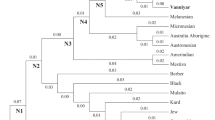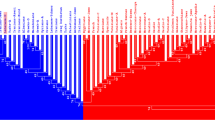Abstract
The present study was aimed to study HLA-DRB1, -DQB1 alleles and haplotypes of two endogamous groups of South India. PCR-SSP typing of HLA-DRB1, -DQB1 alleles were performed on 63 Mukkuvar, primarily a coastal population and 101 Valayar, a population primarily living on the fringes of forest areas. Genetic distances, neighbor-joining dendrograms and correspondence analysis have been performed. The HLA class II alleles, DRB1*07 (32.5%), DRB1*15 (23.0%), DRB1*13 (11.1%) and DRB1*12 (10.3%) were more frequent among Mukkuvar. Among Valayar, DRB1*12 (18.8%), DRB1*15 (17.3%), DRB1*04 (15.4%), DRB1*07 (13.4%) and DRB1*10 (10.9%) were more frequent. Similarly, DQB1*06 (38.1%), DQB1*02 (26.2%) and DQB1*05 (20.5%) alleles among Mukkuvar and DQB1*06 (40.2%) and DQB1*05 (28.9%) among Valayar were more frequent. We genotyped the two most common South Indian two-locus haplotypes, such as DRB1*15-DQB1*06 and DRB1*07-DQB1*02 for HLA-A, -B and -C alleles to identify the 5-locus extended haplotypes. We identified the presence of a highly unique extended haplotype A*03-B*35-C*12-DRB1*07-DQB1*02 in Valayar (HF: 0.2777) and Mukkuvar (HF: 0.1666) hitherto not reported in any of the world populations. The HLA-DRB1 allele based phylogenetic analysis have demonstrated the unique and distinct phylogenetic relatedness of Mukkuvar and Valayar with other ethnic populations. The coastal population Mukkuvar is more closely related to Hispanic and Guanche populations. However, the Valayar revealed phylogenetic relatedness with Austronesian and Micronesian populations supporting the theory of coastal migrations of Out-of-Africa ancestral founding populations.





Similar content being viewed by others
REFERENCES
Mehra, N.K., Genetic diversity of HLA polymorphism and new genes, Ind. J. Hum. Genet., 1998, vol. 4, pp. 1—12.
Rowe, J.H., The renaissance foundations of anthropology, Am. Anthropol., 1965, vol. 67, pp. 1–20.
Ramaswami, A., Gazetteer of India, Ramanathapuram District, Tamil Nadu State, Government of Tamil Nadu, 1972.
Mack, S.J., Bugawan, T.L., Moonsamy, P.V., et al., Evolution of Pacific/Asian populations inferred from HLA class II allele frequency distributions, Tissue Antigens, 2000, vol. 55, pp. 383—400. https://doi.org/10.1034/j.1399-0039.2000.550501.x
Rajasekar, R., Kakkanaiah, V.N., Pitchappan, R.M., HLA antigens in South India: II. Selected caste groups of Tamil Nadu, Tissue Antigens, 1987, vol. 30, pp. 113—118. https://doi.org/10.1111/j.1399-0039.1987.tb01606.x
Pitchappan, R.M., Balakrishnan, K., Sudarsen, V., et al., Sociobiology and HLA genetic polymorphism in hill tribes, the Irula of the Nilgiris hills and the Malayali of the Shevroy hills, South India, Hum. Biol., 1997, vol. 69, no. 1, pp. 59—74.
Balakrishnan, K., Rathika, C., Kamaraj, R., et al., Gradients in the distribution of HLA-DRB1* alleles in caste and tribes in South India, Int. J. Hum. Genet., 2012, vol. 12, no. 1, pp. 45—55. https://doi.org/10.1080/09723757.2012.11886162
Brahmajothi, V., Pitchappan, R.M., Kakkanaiah, V.N., et al., Association of pulmonary tuberculosis and HLA in South India, Tubercle, 1991, vol. 72, no. 2, pp. 123—132. https://doi.org/10.1016/0041-3879(91)90039-U
Selvaraj, P., Uma, H., Reetha, A.M., et al., HLA antigen profile in pulmonary tuberculosis patients and their spouses, Indian J. Med. Res., 1998, vol. 107, pp. 155—158.
Ravikumar, M., Dheenadhayalan, V., Rajaram, K., et al., Association of HLA DRB1, DQB1 and DPB1 alleles with pulmonary tuberculosis in South India, Tubercle Lung Dis., 1999, vol. 79, no. 5, pp. 309—317. https://doi.org/10.1054/tuld.1999.0213
Pitchappan, R.M., Castes, migration, immunogenetics and infectious diseases in South India, Commun. Genet., 2002, vol. 5, pp. 157—161. https://doi.org/10.1159/000066329
Miller, S.A., Dykes, D.D., and Polesky, H.F., A simple salting out procedure for extracting DNA from human nucleate cells, Nucleic Acids Res., 1988, vol. 16, p. 1215. https://doi.org/10.1093/nar/16.3.1215
McGilvray, D.B., Crucible of Conflict: Tamil and Muslim Society on the East Coast of Sri Lanka, Duke University Press, 2008, vol. 64.
George, J.A., Royal Asiatic Society of Great Britain and Ireland Ceylon Branch, J. Ceylon Branch R. Asiat. Soc., 1967, vol. 42, pp. 11—15.
Hoole, R., The Debasement of the Law and of Humanity and the Drift towards Total War, Thirunelvely: University of Jaffna, 1991.
Venkatrama Ayyar, K.R., A Manual of the Pudukkottai State, 1938, vol. 1, р. 106.
Olerup, O. and Zetterquist, H., HLA-DR typing by PCR amplification with sequence-specific primers (PCR-SSP) in 2 hours: an alternative to serological DR typing in clinical practice including donor matching in cadaveric transplantation, Tissue Antigens, 1992, vol. 39, pp. 225—235. https://doi.org/10.1111/j.1399-0039.1992.tb01940.x
Court, M.H. and Michael, H., Court’s(2005—2008)Online Calculator, Tuft University Website, 2012.
Balakrishnan, V., A preliminary study of genetic distances among some populations of the Indian subcondinent, J. Hum. Evo, 1978, vol. 7, pp. 67—75.
Balakrishnan, V., Admixure as an evolutionary force in populations of the Indian subcondinent, in Proceeding of the Indian Statstical Institute Golden Jubilee International Conference, vol. I: Human Genetics and Adaptation, Malkotra, K.C. and Amitabha Basu, Eds., Calcutta: Indian Statistical Institute, 1982, pp. 103—145.
Sanghvi, L.D., Balakrishnan, V., and Karve, I., Biology of the People of Tamil Nadu, Pune: Indian Society of Human Genetics and Calcutta, 1981.
Balakrishnan, K., Pitchappan, R.M., Suzuki, K., et al., HLA affinities of Iyers: a Brahmin population of Tamil Nadu, South India, Hum. Biol., 1996, vol. 68, no. 4, pp. 523—537.
Shanmugalakshmi, S., Balakrishnan, K., Manoharan, K., and Pitchappan, R.M., HLA DRB1*, DQB1* in Piramalai Kallars and Yadhavas, two Dravidian speaking castes of Tamil Nadu, South India, Tissue Antigens, 2003, vol. 61, pp. 451—464. https://doi.org/10.1034/j.1399-0039.2003.00061.x
Degli-Esposti, M.A., Leaver, A.L., Christiansen, F.T., et al., Ancestral haplotypes: conserved population MHC haplotypes, Hum. Immunol., 1992, vol. 34, no. 4, pp. 242—252. https://doi.org/10.1016/0198-8859(92)90023-G
Aravind, S.R., Prabha, S., Rathika, C., et al., Association of HLA-DR/DQ alleles and haplotypes with nephrotic syndrome, Nephrology (Carlton), 2015, vol. 21, no. 9, pp. 745—752. https://doi.org/10.1111/nep.12669
ACKNOWLEDGMENTS
We thank all blood donors for their voluntary support. We also acknowledge Mrs. Sheeba Nancy, Research Scholar, Mother Teresa Women’s University for statistical support. We extend our gratitude to the authorities of the Scott Christian College, Nagercoil for population sampling during the period 2015–2016.
Funding
This work was supported by the UGC, Government of India through ‘Research Fellowship in Science’ for the Meritorious Students Scheme (R. Kamaraj/F. No. 25-1/2014-15 (BSR)/5-67/2007) and Tissue Typing Services, Madurai Kamaraj University (Prof. K. Balakrishnan).
Author information
Authors and Affiliations
Contributions
Author contributions are as follows.
Study design: Kamaraj; Sampling: Kamaraj, Balakrishnan, Dhivakar, Albert, Justin, Navaneetha Kannan; Data Collection: Kamaraj, Dhivakar, Rathika; Data Analysis: Kamaraj; Manuscript Preparation: Kamaraj, Balakrishnan.
ORCID
Kamaraj Raju https://orcid.org/0000-0002-5724-0780.
Corresponding author
Ethics declarations
COMPLIANCE WITH ETHICAL STANDARDS
Conflict of interest. The authors declare that they have no conflict of interest.
Statement of compliance with standards of research involving humans as subjects. All procedures performed in the study are consistent with the ethical standards of the institutional ethics committee. Institutional ethical clearance was obtained from Madurai Kamaraj University (Ethical and Review Board Committee).
Rights and permissions
About this article
Cite this article
Kamaraj, R., Balakrishnan, K., Dhivakar, M. et al. Distribution of HLA Alleles and Haplotypes in Tamil-Speaking South Indian Populations: Affinities with Spanish and Austronesian. Russ J Genet 56, 1139–1150 (2020). https://doi.org/10.1134/S1022795420090100
Received:
Revised:
Accepted:
Published:
Issue Date:
DOI: https://doi.org/10.1134/S1022795420090100




